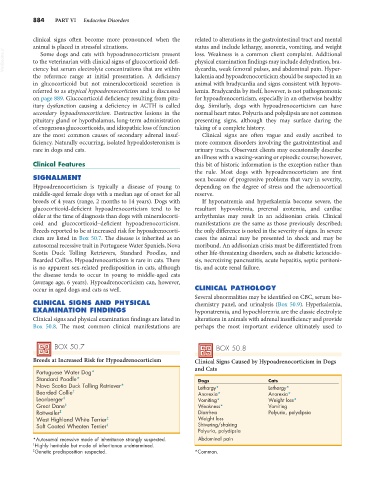Page 912 - Small Animal Internal Medicine, 6th Edition
P. 912
884 PART VI Endocrine Disorders
clinical signs often become more pronounced when the related to alterations in the gastrointestinal tract and mental
animal is placed in stressful situations. status and include lethargy, anorexia, vomiting, and weight
VetBooks.ir to the veterinarian with clinical signs of glucocorticoid defi- loss. Weakness is a common client complaint. Additional
Some dogs and cats with hypoadrenocorticism present
physical examination findings may include dehydration, bra-
ciency but serum electrolyte concentrations that are within
kalemia and hypoadrenocorticism should be suspected in an
the reference range at initial presentation. A deficiency dycardia, weak femoral pulses, and abdominal pain. Hyper-
in glucocorticoid but not mineralocorticoid secretion is animal with bradycardia and signs consistent with hypovo-
referred to as atypical hypoadrenocorticism and is discussed lemia. Bradycardia by itself, however, is not pathognomonic
on page 889. Glucocorticoid deficiency resulting from pitu- for hypoadrenocorticism, especially in an otherwise healthy
itary dysfunction causing a deficiency in ACTH is called dog. Similarly, dogs with hypoadrenocorticism can have
secondary hypoadrenocorticism. Destructive lesions in the normal heart rates. Polyuria and polydipsia are not common
pituitary gland or hypothalamus, long-term administration presenting signs, although they may surface during the
of exogenous glucocorticoids, and idiopathic loss of function taking of a complete history.
are the most common causes of secondary adrenal insuf- Clinical signs are often vague and easily ascribed to
ficiency. Naturally occurring, isolated hypoaldosteronism is more common disorders involving the gastrointestinal and
rare in dogs and cats. urinary tracts. Observant clients may occasionally describe
an illness with a waxing-waning or episodic course; however,
Clinical Features this bit of historic information is the exception rather than
the rule. Most dogs with hypoadrenocorticism are first
SIGNALMENT seen because of progressive problems that vary in severity,
Hypoadrenocorticism is typically a disease of young to depending on the degree of stress and the adrenocortical
middle-aged female dogs with a median age of onset for all reserve.
breeds of 4 years (range, 2 months to 14 years). Dogs with If hyponatremia and hyperkalemia become severe, the
glucocorticoid-deficient hypoadrenocorticism tend to be resultant hypovolemia, prerenal azotemia, and cardiac
older at the time of diagnosis than dogs with mineralocorti- arrhythmias may result in an addisonian crisis. Clinical
coid and glucocorticoid–deficient hypoadrenocorticism. manifestations are the same as those previously described;
Breeds reported to be at increased risk for hypoadrenocorti- the only difference is noted in the severity of signs. In severe
cism are listed in Box 50.7. The disease is inherited as an cases the animal may be presented in shock and may be
autosomal recessive trait in Portuguese Water Spaniels, Nova moribund. An addisonian crisis must be differentiated from
Scotia Duck Tolling Retrievers, Standard Poodles, and other life-threatening disorders, such as diabetic ketoacido-
Bearded Collies. Hypoadrenocorticism is rare in cats. There sis, necrotizing pancreatitis, acute hepatitis, septic peritoni-
is no apparent sex-related predisposition in cats, although tis, and acute renal failure.
the disease tends to occur in young to middle-aged cats
(average age, 6 years). Hypoadrenocorticism can, however,
occur in aged dogs and cats as well. CLINICAL PATHOLOGY
Several abnormalities may be identified on CBC, serum bio-
CLINICAL SIGNS AND PHYSICAL chemistry panel, and urinalysis (Box 50.9). Hyperkalemia,
EXAMINATION FINDINGS hyponatremia, and hypochloremia are the classic electrolyte
Clinical signs and physical examination findings are listed in alterations in animals with adrenal insufficiency and provide
Box 50.8. The most common clinical manifestations are perhaps the most important evidence ultimately used to
BOX 50.7 BOX 50.8
Breeds at Increased Risk for Hypoadrenocorticism Clinical Signs Caused by Hypoadrenocorticism in Dogs
and Cats
Portuguese Water Dog*
Standard Poodle* Dogs Cats
Nova Scotia Duck Tolling Retriever* Lethargy* Lethargy*
Bearded Collie † Anorexia* Anorexia*
Leonberger ‡ Vomiting* Weight loss*
Great Dane ‡ Weakness* Vomiting
Rottweiler ‡ Diarrhea Polyuria, polydipsia
West Highland White Terrier ‡ Weight loss
Soft Coated Wheaten Terrier ‡ Shivering/shaking
Polyuria, polydipsia
*Autosomal recessive mode of inheritance strongly suspected. Abdominal pain
† Highly heritable but mode of inheritance undetermined.
‡ Genetic predisposition suspected. *Common.

